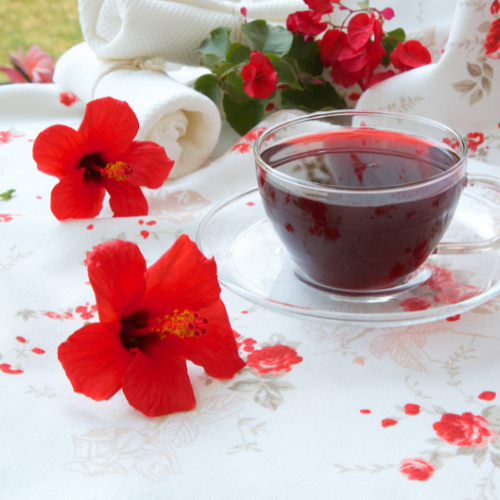Introduction:
Hibiscus iced tea is more than just a refreshing beverage; it’s a vibrant drink that has been enjoyed for centuries across various cultures. Known for its deep red color and tart flavor, hibiscus tea is made from the dried petals of the hibiscus flower, which is packed with nutrients and health benefits. In this comprehensive guide, we will explore the origins, preparation, health benefits, variations, and much more about hibiscus iced tea.
Nutritional Profile of Hibiscus Iced Tea.
Hibiscus tea is not only refreshing but also boasts a rich nutritional profile. Here are some key nutrients found in hibiscus tea:
- Vitamin C: Hibiscus is high in vitamin C, which is essential for immune function and skin health.
- Antioxidants: The tea contains powerful antioxidants like anthocyanins, which help combat oxidative stress in the body.
- Minerals: Hibiscus provides essential minerals such as calcium, iron, and magnesium.
- Organic Acids: It contains organic acids like citric and malic acid, contributing to its tart flavor and potential health benefits.
Health Benefits of Hibiscus Iced Tea.
1. Rich in Antioxidants
Hibiscus tea is packed with antioxidants that help neutralize free radicals in the body. This can reduce the risk of chronic diseases and promote overall health.
2. Supports Heart Health
Research suggests that hibiscus tea may help lower blood pressure and cholesterol levels. Regular consumption can potentially reduce the risk of heart disease by improving overall cardiovascular health.
3. Aids Digestion
Hibiscus tea has mild laxative properties, which can aid digestion and help prevent constipation. Its natural acidity can also stimulate gastric juices, promoting better digestion.
4. Weight Management
Some studies indicate that hibiscus tea may assist in weight management by inhibiting the absorption of starch and glucose. This effect can help regulate body weight and support a healthy metabolism.
5. Supports Liver Health
Hibiscus has been shown to have hepatoprotective properties, meaning it can help protect the liver from damage and support its overall function.
6. Boosts Immune Function
The high vitamin C content in hibiscus tea can enhance immune function, making it a great choice during cold and flu season.
7. Promotes Healthy Skin
The antioxidants found in hibiscus tea may help maintain skin elasticity and reduce the appearance of wrinkles, promoting a youthful complexion.
How to Prepare Hibiscus Iced Tea.
Ingredients
- 1 cup dried hibiscus petals
- 4 cups water
- Sweetener (optional, such as honey, agave syrup, or stevia)
- Lemon or lime slices (for garnish)
- Fresh mint leaves (optional, for garnish)
Instructions.
- Boil Water: In a pot, bring 4 cups of water to a boil.
- Add Hibiscus Petals: Once boiling, remove the pot from heat and add the dried hibiscus petals. Stir well.
- Steep: Cover the pot and let the petals steep for about 15-20 minutes. The longer you steep, the more intense the flavor will be.
- Strain: After steeping, strain the tea through a fine mesh sieve or cheesecloth to remove the petals.
- Sweeten (Optional): If desired, add your preferred sweetener while the tea is still warm and stir until dissolved.
- Chill: Allow the tea to cool to room temperature, then refrigerate until chilled.
- Serve: Serve over ice with lemon or lime slices and mint leaves for garnish.
Variations of Hibiscus Iced Tea.
1. Hibiscus Mint Iced Tea
Add fresh mint leaves to the steeping process for a refreshing minty flavor. Garnish with additional mint leaves when serving.
2. Hibiscus and Berry Iced Tea
Mix hibiscus tea with blended berries like strawberries, raspberries, or blueberries for a fruity twist. This adds natural sweetness and boosts the antioxidant content.
3. Hibiscus Citrus Iced Tea
Infuse the tea with slices of citrus fruits such as orange, lemon, or grapefruit for an extra zing. This variation enhances the vitamin C content and adds a refreshing flavor.
4. Hibiscus Ginger Iced Tea
Add fresh ginger slices to the hibiscus tea while it steeps for a spicy kick. Ginger is known for its anti inflammatory benefits and adds depth to the flavor.
5. Sparkling Hibiscus Iced Tea
For a fizzy treat, mix chilled hibiscus tea with sparkling water or soda. This variation is perfect for summer gatherings and adds a fun twist to the classic beverage.
Hibiscus Iced Tea in Different Cultures.
Hibiscus tea is enjoyed in various forms around the world, each with its own unique twist:
- Agua de Jamaica: In Mexico, this sweetened hibiscus drink is often served chilled with sugar and lime. It’s a popular beverage for celebrations and parties.
- Karkade: In Egypt and Sudan, hibiscus tea is consumed both hot and cold, often sweetened with sugar and infused with mint.
- Bissap: In Senegal and other West African countries, hibiscus tea is made with additional spices like ginger and mint and served sweetened, often at social gatherings.
Tips for Brewing the Perfect Hibiscus Iced Tea.
- Quality Ingredients: Use high quality, organic dried hibiscus petals for the best flavor and health benefits.
- Adjust Sweetness: Hibiscus tea has a naturally tart flavor. Adjust the sweetness to your taste, but consider using natural sweeteners for a healthier option.
- Experiment with Flavors: Don’t hesitate to experiment with different fruits and herbs to create your unique blends.
- Serve Chilled: Hibiscus iced tea is best served chilled, making it a perfect refreshment for hot days.
- Store Properly: Keep any leftover hibiscus tea in the refrigerator for up to a week. Consider adding fresh garnishes just before serving.
Potential Side Effects and Considerations.
While hibiscus tea is generally safe for most people, there are some considerations to keep in mind:
- Blood Pressure: Since hibiscus tea can lower blood pressure, individuals with low blood pressure or those on antihypertensive medications should consult a healthcare professional before consumption.
- Pregnancy: Pregnant women should exercise caution, as hibiscus tea may affect hormone levels. It’s best to consult a healthcare provider.
- Allergies: Some individuals may be allergic to hibiscus. If you experience any allergic reactions, discontinue use immediately.
Conclusion.
Hibiscus iced tea is a flavorful and healthful beverage that offers a myriad of benefits. With its rich history, delightful taste, and impressive nutritional profile, it’s no wonder that hibiscus tea has become a favorite around the world. Whether enjoyed plain or infused with other flavors, this refreshing drink is a simple way to boost your health and stay hydrated. So, the next time you’re looking for a delicious and nutritious drink, consider brewing a batch of hibiscus iced tea!
Subscribe to Incredibly Healthy: https://bit.ly/subscribe-incrediblyhe…
Questions and Answers:
1. What are the main health benefits of hibiscus iced tea?
Hibiscus iced tea is rich in antioxidants, supports heart health, aids digestion, promotes weight management, and boosts immune function.
2. How do you prepare hibiscus iced tea?
To prepare hibiscus iced tea, steep dried hibiscus petals in boiling water, strain, chill, and serve over ice. Sweeten if desired.
3. Can hibiscus tea lower blood pressure?
Yes, studies suggest that hibiscus tea can help lower blood pressure, making it beneficial for cardiovascular health.
4. Is hibiscus iced tea safe during pregnancy?
Pregnant women should consult with a healthcare provider before consuming hibiscus iced tea, as it may affect hormone levels.
5. What are some variations of hibiscus iced tea?
Variations include hibiscus mint iced tea, hibiscus and berry iced tea, hibiscus citrus iced tea, hibiscus ginger iced tea, and sparkling hibiscus iced tea.

